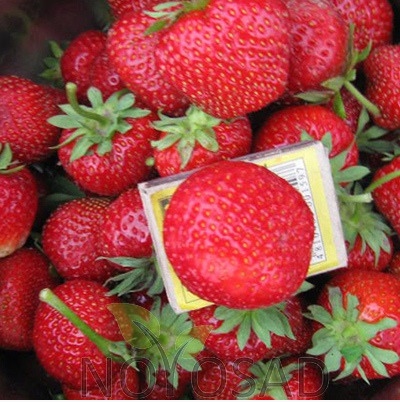
- Authors: English selection
- Name synonyms: Pegasus
- Taste: sweet and sour
- The size: medium and large
- Weight: from 20 g
- Yield rate: high
- Yield: 1-2 kg per bush
- Repairability: No
- Ripening terms: medium
- Appointment: fresh consumption, processing (juice, jam, jam, etc.)
Pegasus strawberry is one of the popular varieties of the famous berry. The culture is easy to care for, gives a high yield and survives the winter well. These are the main characteristics for which gardeners appreciate the berry.
Description of the variety
Pegasus is a sturdy, vigorous shrub with medium-sized leaves. The peduncles of the variety are erect, grow in large quantities at the onset of the season.
Ripening terms
Pegasus strawberries are medium-ripening varieties. The first berries appear at the height of the summer season. The culture continues to bear fruit until the end of September.
Yield
The maximum yield that can be harvested from one bush is 2 kg.
Berries and their taste
The culture gives large berries, the weight of one reaches from 20 g. Pegasus strawberries have a conical shape. The pulp is dense, has a homogeneous elastic structure. Berry color: red, the fruit tastes sweet and sour, reminiscent of strawberries. Berries of the variety can be used for cooking:
jam;
jam;
compote.
When frozen, they retain their taste and appearance.
Growing features
Pegasus does not require special care, and this is a distinctive feature of the variety. To get a good harvest, it is enough to take care of timely watering and fertilization of the soil.




Site selection and soil preparation
Experienced gardeners recommend paying attention to the strawberry planting site. The variety is not friendly with winds, therefore, preference should be given to open sunny areas on the south side, where there is practically no blow.
Additional recommendations.
The acidity level of the soil should be moderate. In too acidic or alkaline soil, it is worth adding organic fertilizers or mineral additives, respectively, to neutralize.
Groundwater should flow low to avoid flooding the plant roots.Otherwise, the strawberries will rot and will not yield a bountiful harvest.
It is important to consider the compatibility of strawberries with other plants. Avoid planting this variety next to potatoes, cabbage, or eggplants. Greens and marigolds will become good neighbors.
It is not necessary to plant the variety twice in the same place, otherwise the soil will not have time to be filled with nutrients lost during the season.
Before planting strawberries, it is worth carefully preparing the site, clearing it of weeds and debris. If the weeds are too deeply rooted, you must first dig up the area and only then start planting. Before lowering the seedlings into the prepared hole, it is also worth adding organic fertilizers.

Pollination
Under natural growing conditions - in a greenhouse or in a garden bed - strawberry flowers are pollinated by insects. If the variety is planned to be grown at home, it is worth taking care of artificial pollination of flowers.
Top dressing
Recommendations for top dressing:
making compositions no closer than 5 cm from the bush;
4 dressings per season;
dilution of concentrated solutions with water.
Timing of feeding strawberries:
after two weeks from the moment of planting, it is necessary to add wood ash and superphosphates diluted in 10 liters of water to the soil;
at the beginning of flowering, it is recommended to add a weekly infusion of organic compounds - mullein, chicken droppings, wood ash;
every 14 days after the beginning of flowering, top dressing with superphosphates and ash is appropriate.
At the end of fruiting, it is worth adding additional feeding.

One of the important techniques in strawberry care is feeding. Regular fertilization guarantees a rich harvest. There are several different ways to feed strawberries, and each of them is designed for a specific period of plant development. During flowering, fruiting and after it, feeding should be different.
Frost resistance and the need for shelter
Strawberries are frost and drought resistant and require little maintenance. To prepare the culture for the cold weather, it is recommended to cover the bushes with a small layer of cloth and apply fertilizer.

Diseases and pests
The berry is resistant to most diseases and insect attacks. However, this does not mean that the variety is able to cope with all types of pests. Strawberries can be attacked by some of them.
Transparent mite. Carbofos will help to cope with it. Processing is best done after harvesting the fruit.
Nematodes. In this case, it will be necessary to dig up the affected bushes in order to prevent an epidemic.
Snails and slugs. Not insects, but also impair the growth of strawberry bushes.
If you correctly approach the issue of crop prevention, it will give an excellent harvest.

Strawberries are often subject to many dangerous diseases that can seriously undermine its condition. Among the most common are powdery mildew, gray mold, brown spot, anthracnose, and verticillosis. Before buying a variety, you need to inquire about its disease resistance.
Reproduction
A common option for obtaining planting material is to grow new seedlings from vegetative shoots, which are mustaches. And also reproduction can be done by dividing the bush.



















































































